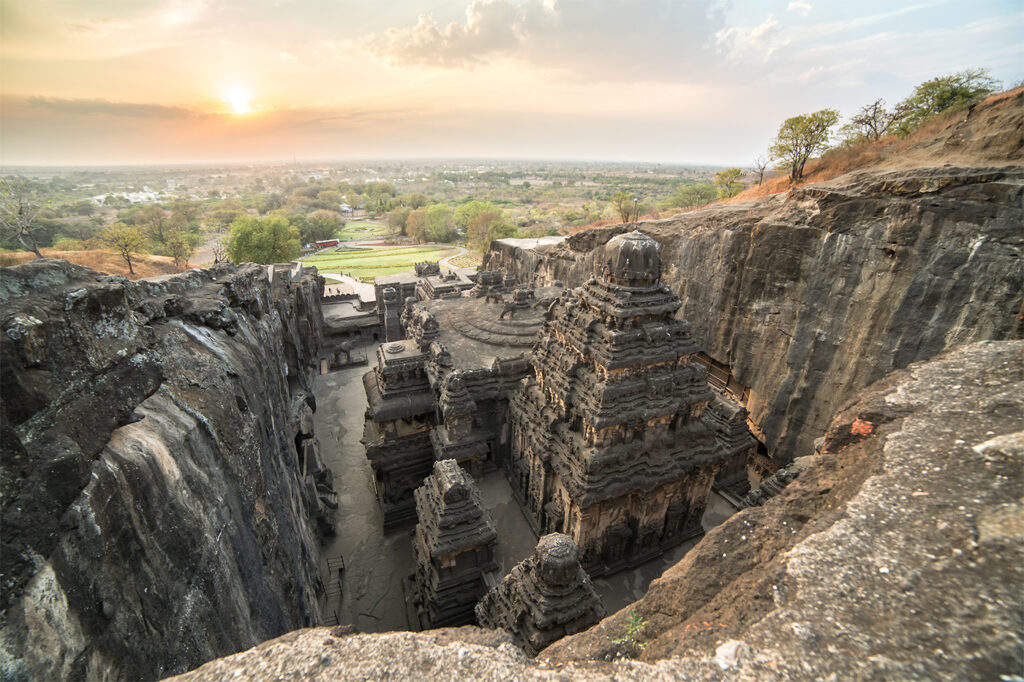
The Kailasa Temple at Ellora Caves: A Monumental Wonder of Ancient India
The Kailasa Temple at the Ellora Caves is a breathtaking marvel that truly showcases the genius of ancient Indian artisans. Carved from a single massive rock, this temple dedicated to Lord Shiva stands as a testament to the architectural and engineering brilliance of the 8th-century craftsmen. The sheer scale and intricate detailing—from the towering spires to the delicate carvings of mythological scenes—are awe-inspiring and transport visitors to a different era.
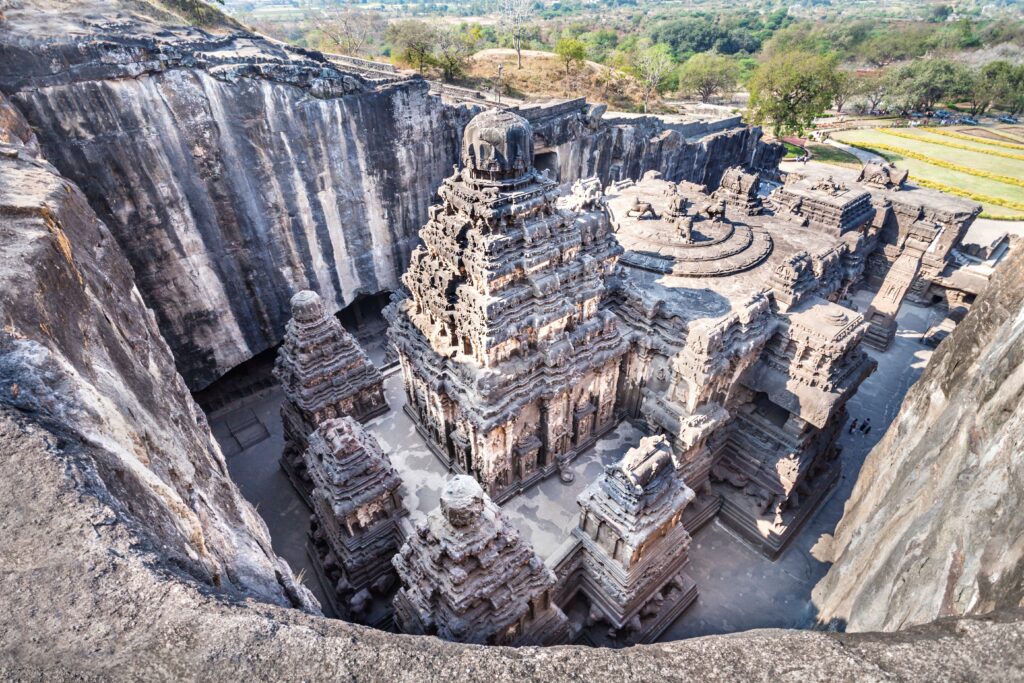
A visit to the Kailasa Temple is not only a visual feast but also a deeply spiritual experience, offering insight into the devotion and craftsmanship of a bygone era. The temple’s mystery—how such a monumental structure was created without modern tools—only adds to its allure. For history enthusiasts, architecture lovers, or spiritual seekers, the Kailasa Temple is an essential, unforgettable destination that encapsulates the grandeur of India’s cultural heritage.
The History and Context of the Ellora Caves
The Ellora Caves, a UNESCO World Heritage Site located in the Aurangabad district of Maharashtra, India, stand as one of the greatest examples of rock-cut architecture in the world. Carved between the 6th and 9th centuries CE, these caves showcase India’s rich cultural and religious diversity, featuring 34 monasteries and temples dedicated to Buddhism, Hinduism, and Jainism. The site is a testament to the coexistence of these major Indian religions, reflecting the tolerance and spiritual synergy that defined much of India’s ancient history.
Early Origins and Patronage
The construction of the Ellora Caves is believed to have begun around the 6th century CE during the rule of the Kalachuri dynasty, who likely initiated the early Buddhist caves. However, the site reached its architectural zenith under the Rashtrakuta dynasty (8th to 10th centuries CE), who not only expanded the existing caves but also sponsored some of the most iconic structures, including the magnificent Kailasa Temple.

The Rashtrakuta king Krishna I, a devout Shaivite, is credited with commissioning the Kailasa Temple, which was dedicated to Lord Shiva and modeled after Mount Kailash, Shiva’s mythical abode. The construction of this temple demonstrated the political power and cultural ambitions of the Rashtrakuta dynasty, aiming to rival or even surpass other monumental structures of the time.
The Three Religious Traditions at Ellora
The Ellora complex is unique in that it houses monuments from three major Indian religions, each with distinct architectural and artistic styles:
- Buddhist Caves (Caves 1-12): The earliest excavations at Ellora are Buddhist monasteries and temples, dating back to the 6th and 7th centuries. These caves include intricate carvings of Buddha, Bodhisattvas, and scenes from Jataka tales. Cave 10, also known as the “Vishvakarma Cave” or “Carpenter’s Cave,” features an impressive stupa hall with ribbed ceilings carved to resemble wooden beams, demonstrating the blending of architecture with religious symbolism.
- Hindu Caves (Caves 13-29): The Hindu caves are the most elaborate and grandiose structures at Ellora, with Cave 16, the Kailasa Temple, as the crown jewel. Carved between the 7th and 9th centuries under the Rashtrakuta rulers, these temples showcase detailed carvings of deities from Hindu mythology, including scenes from the Mahabharata and Ramayana. Each Hindu cave exhibits a complexity in planning and execution, with multi-story layouts, grand halls, and vivid iconography designed to inspire awe and devotion.
- Jain Caves (Caves 30-34): Constructed during the 9th and 10th centuries, the Jain caves reflect the influence of the Digambara sect and were likely completed during the Yadava dynasty’s rule. Despite being relatively smaller, the Jain caves are rich in symbolism and include beautifully carved lotus motifs, pillars, and intricate depictions of the Tirthankaras. Cave 32, known as the Indra Sabha, is notable for its elegant architecture and elaborate carvings that reflect the Jain ideals of simplicity and purity.
Architectural Techniques and Innovations

The Ellora Caves are known for their sophisticated rock-cut techniques, wherein artisans carved directly into the cliff face of a basaltic hill. The monolithic construction approach—where structures like the Kailasa Temple were carved from a single massive rock—showcases the advanced skills of the artisans and the immense effort required to create these caves. Working from the top down, the builders employed chisels, hammers, and other rudimentary tools to achieve a remarkable level of precision and detail, demonstrating an understanding of structural integrity and spatial planning.
Religious and Cultural Synthesis
Ellora’s blend of Buddhist, Hindu, and Jain monuments illustrates a unique period in Indian history where religious diversity was embraced rather than suppressed. The construction of Buddhist, Hindu, and Jain temples in close proximity signifies a period of tolerance, collaboration, and cultural exchange that fostered artistic innovation. The geographical location of Ellora, near significant trade routes, contributed to the blending of artistic influences, as the site attracted pilgrims, traders, and artists from across India and beyond.
Importance of Ellora in Medieval Indian Society
Ellora was more than just a spiritual center; it was a vibrant cultural hub and a place of education, meditation, and philosophical discourse. Monks, ascetics, and scholars from various sects gathered here, turning the caves into a melting pot of ideas and traditions. The caves also played a role in legitimizing the Rashtrakuta dynasty’s authority, as the Kailasa Temple, in particular, demonstrated the dynasty’s devotion to Hinduism and their architectural prowess.
Rediscovery and Modern-Day Significance
The Ellora Caves were rediscovered during the colonial period and became a subject of fascination for Western scholars and explorers. In recent times, efforts by the Archaeological Survey of India and UNESCO have focused on preserving the caves, given their vulnerability to environmental factors, natural erosion, and the impact of tourism.
Today, Ellora remains one of India’s most popular tourist attractions and a revered pilgrimage site. For historians, architects, and spiritual seekers alike, the Ellora Caves offer a glimpse into India’s past, showcasing a period of artistic brilliance, cultural tolerance, and religious harmony that continues to inspire awe and reverence around the world.
Architectural Marvel of Kailasa Temple
The Kailasa Temple, also known as Cave 16 in the Ellora complex, stands as one of the world’s most astonishing architectural achievements. It is not only the largest monolithic rock excavation in existence but also a masterpiece of ancient Indian craftsmanship, representing the peak of rock-cut architecture. Built during the 8th century by the Rashtrakuta dynasty, this temple was designed to symbolize Mount Kailash, the divine abode of Lord Shiva, embodying both the religious fervor and the architectural ingenuity of the era.
Unique Design
The Kailasa Temple’s design is unique not only in India but globally. Unlike typical temple constructions, which are built from the ground up by stacking stone blocks, the Kailasa Temple was carved directly into the basalt rock of the Charanandri hills. The architects and artisans adopted a top-down approach, carving the structure from a single, massive stone block, and meticulously working their way downward. This extraordinary technique meant that any errors during the process would have been catastrophic and irreversible, underscoring the incredible skill and precision of its creators.
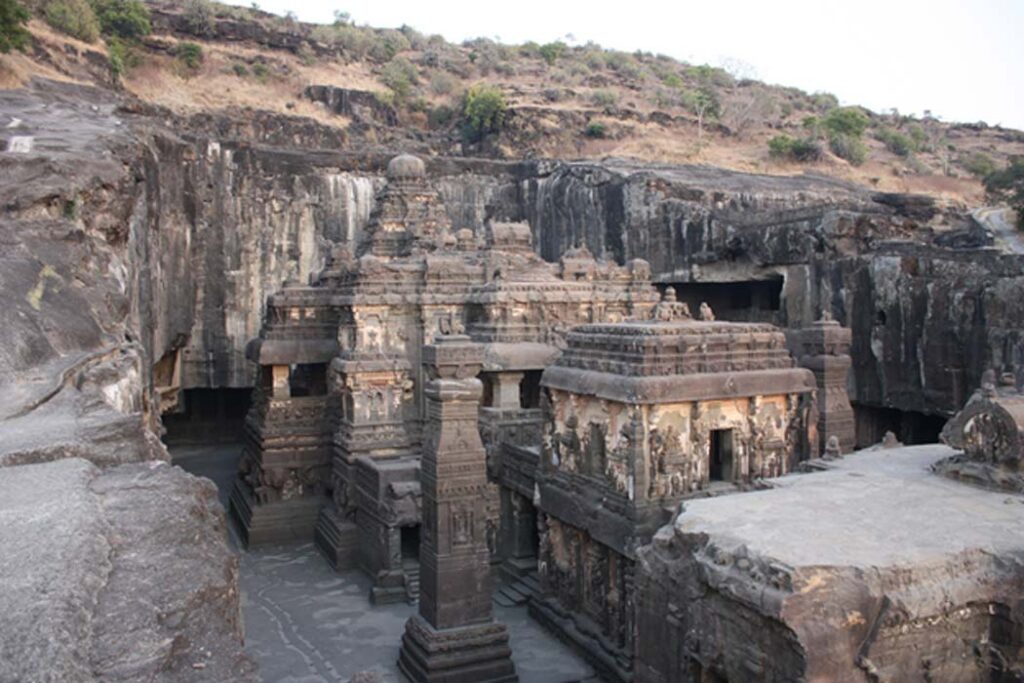
The temple is structured as a grand courtyard, with a towering central shrine surrounded by smaller shrines, halls, and subsidiary structures, all adorned with ornate carvings. The courtyard measures approximately 82 meters long, 46 meters wide, and 33 meters high, with the main shrine standing at its center. This layout includes multiple layers of symbolism, representing the cosmic mountain Mount Kailash, where gods reside, according to Hindu mythology.
One of the most distinctive aspects of the temple’s design is its freestanding elements. Unlike most rock-cut temples, which are embedded within a cliff, the Kailasa Temple includes separate pillars, shrines, and sculptural panels, as well as a grand entrance gate, which give it the appearance of a fully constructed temple rather than a carved structure. The temple is flanked by two life-sized sculptures of elephants, symbolizing strength and stability, that seemingly “support” the weight of the central shrine, adding to the realism and intricacy of the design.
Monolithic Structure
The Kailasa Temple’s monolithic structure is perhaps its most defining feature, carved out of a single, massive rock face. Experts estimate that around 200,000 tons of rock were excavated to create this temple, a feat that likely required years of labor by thousands of skilled artisans, stonemasons, and laborers. The temple’s monolithic nature exemplifies the extraordinary ambition and capabilities of the Rashtrakuta dynasty’s architects, who successfully transformed raw rock into a meticulously planned architectural masterpiece.
Working from the top down, artisans used rudimentary tools—primarily hammers, chisels, and wedges—to remove large sections of basalt. They first carved the roof and exterior decorations, slowly shaping the towering structure and its surrounding features. This approach required an in-depth understanding of rock behavior and a high degree of coordination, as even minor mistakes could ruin the temple’s structure. Today, the Kailasa Temple remains the largest rock-cut, freestanding temple complex of its kind in the world, and it continues to inspire awe for its monolithic grandeur.
Artistic Detailing
The Kailasa Temple is renowned for its intricate artistic detailing, with countless carvings that depict mythological scenes, deities, animals, and celestial beings. The outer walls and inner sanctum are adorned with sculpted panels and friezes that convey both religious and cultural narratives, showcasing the artistry of the Rashtrakuta period.
Mythological Carvings
One of the most striking features of the temple is its vivid depiction of episodes from Hindu mythology, including the Ramayana and the Mahabharata. For instance, a prominent panel depicts the scene of Ravana, the demon king, attempting to lift Mount Kailash, only to be subdued by the mighty Lord Shiva, who presses down on the mountain with his foot, symbolizing his unmatched power. Another remarkable carving shows scenes from the Mahabharata, illustrating the epic’s heroes, deities, and significant battles with an expressive realism that brings these stories to life.
The temple’s detailed carvings are not confined to religious iconography alone; they also include life-like depictions of animals such as elephants, lions, and bulls, each symbolizing different aspects of strength, wisdom, and divinity in Hinduism. The animals appear to be in dynamic motion, and the attention to detail—right down to the texture of their skin and fur—demonstrates the skill of the artisans.
Architectural and Sculptural Motifs
Beyond mythological scenes, the Kailasa Temple’s design incorporates architectural motifs that resemble free-standing South Indian temples, complete with columns, brackets, and stepped pyramid-like structures. The pillars are intricately decorated with floral designs, geometric patterns, and inscriptions, showing both artistic sophistication and mathematical precision. This artistic detailing was designed to mirror a fully constructed temple, and it creates a sense of illusion, as though the temple were assembled rather than carved from rock.
The roof of the main shrine is crowned with a Dravidian-style shikhara (spire), which rises above the temple complex, reaching for the heavens in a symbolic representation of Mount Kailash. The shikhara is adorned with miniature shrines and decorative motifs, emphasizing the temple’s grandeur and attention to every detail, down to the smallest ornament.
Symbolism and Spiritual Depth
Each carving, statue, and decorative element within the Kailasa Temple was meticulously designed with spiritual symbolism. For example, the temple’s inner sanctum, which houses a large lingam (an aniconic representation of Shiva), is the focal point of the complex, symbolizing the presence of divine power. Pilgrims and devotees move from the outer courtyard inward, a journey that symbolizes the soul’s progression from the material world into spiritual enlightenment and union with the divine.
Additionally, the temple is aligned in a way that harnesses natural light, casting an ethereal glow onto the central lingam at specific times of day, enhancing the spiritual experience for devotees. The carvings surrounding the sanctum illustrate various forms of Shiva, from the fierce Bhairava to the serene Yogeshwara, presenting a holistic view of the god’s divine aspects and reinforcing the temple’s purpose as a place of worship and meditation.
Influence and Legacy
The architectural and artistic achievements of the Kailasa Temple had a profound influence on Indian temple architecture and continue to inspire architects and historians around the world. Its monolithic design and rich carvings laid the foundation for later rock-cut temples and influenced South Indian temple architecture, particularly in the Deccan region. The Kailasa Temple’s legacy endures not only in the history of Indian art but also in the collective imagination of the Indian people, who view it as a symbol of their ancient heritage and spiritual devotion.
Mysteries and Theories of Construction
The construction of the Kailasa Temple remains one of the greatest mysteries of ancient engineering. This colossal, intricately designed temple, carved from a single massive rock, stands as a monument to the seemingly impossible feats achieved by Indian artisans and builders over a millennium ago. How the temple was constructed without modern machinery or advanced engineering tools has sparked debate and wonder among historians, architects, and archaeologists for centuries. The temple’s scale, precision, and complexity have led to various theories on how it might have been accomplished, but many aspects remain unexplained.
The Scale of the Task: Carving a Mountain
The Kailasa Temple, carved directly into a cliff face of the Charanandri hills, measures around 82 meters (270 feet) long, 46 meters (150 feet) wide, and 33 meters (108 feet) high. Experts estimate that over 200,000 tons of rock had to be removed to shape the temple—a feat that would have required extraordinary planning and skill. Unlike other rock-cut temples, where the structure is typically carved into the side of a cliff and remains partially embedded within it, the Kailasa Temple is a freestanding monolithic structure, fully detached from the surrounding rock. This gives the temple the appearance of a constructed structure rather than one carved from rock, adding to its mystique.
To carve such an enormous temple from the top down, artisans had to work with extreme precision, carefully removing massive amounts of rock while simultaneously sculpting intricate designs, statues, and symbolic motifs. Any miscalculations could have compromised the integrity of the entire structure. The question of how they managed to do this with such limited tools has led to a range of theories and speculations, each attempting to unlock the secrets of this ancient engineering marvel.
Tools and Techniques: Evidence from Ancient Carvings
Based on historical evidence, it’s believed that artisans used basic tools—chisels, hammers, and possibly copper or iron instruments—to carve the temple. However, basalt rock, the material from which the temple is carved, is incredibly hard and difficult to work with, especially when trying to achieve the level of detail seen in Kailasa. Without access to steel tools, which were not commonly used until later periods, the builders would have needed tremendous expertise to avoid breakage and achieve smooth cuts in such hard stone.
One technique that may have been employed is known as “percussion flaking,” where skilled artisans use controlled strikes with chisels and hammers to gradually remove material. However, this technique would still have required a huge workforce and likely decades to complete, which aligns with theories suggesting that the construction spanned several generations. Additionally, there are theories that artisans might have used controlled fire to heat the rock, followed by water to cool and fracture it. This could have made carving the basalt easier, but evidence supporting this method is largely speculative.
Theories on the Workforce and Timeline
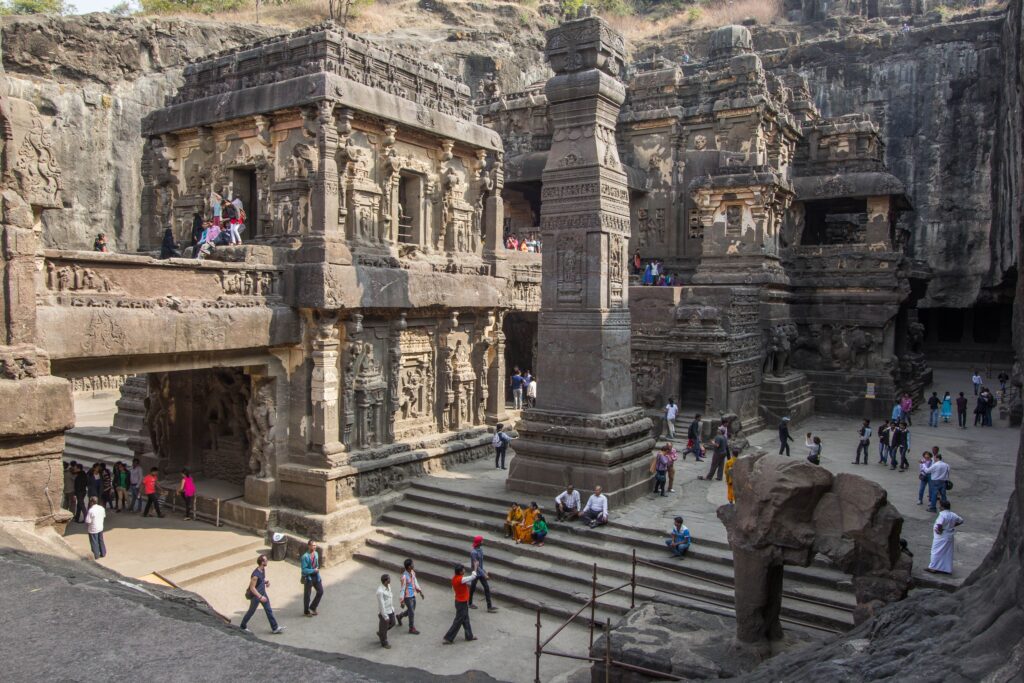
Several theories suggest that thousands of laborers and artisans would have been involved in constructing the Kailasa Temple, possibly working in shifts over several decades. The Rashtrakuta dynasty, known patrons of art and architecture, might have employed specialized guilds of artisans, stone cutters, and sculptors to ensure continuity and high-quality craftsmanship.
Ancient texts do mention large-scale construction projects supported by royal patronage, where artisans were provided for by the state. Yet even with such a large workforce, the time required to complete such a massive undertaking would have been significant. Some historians estimate that it may have taken between 18 to 25 years to complete the temple if thousands of workers were consistently employed. This rapid timeline for such an elaborate structure has led some researchers to wonder if unknown, advanced techniques may have been used, as the sheer scale and precision of the work would otherwise seem almost impossible.
Unsolved Mysteries: Advanced Techniques or Lost Knowledge?
The sheer scale and precision of the Kailasa Temple’s construction have led some scholars and enthusiasts to propose theories involving advanced techniques or lost ancient knowledge. While there is no evidence to support such claims definitively, some believe that the Kailasa Temple, like other ancient wonders, may reflect a level of architectural sophistication that hasn’t yet been fully understood.
One theory suggests that artisans may have possessed a form of ancient geometric knowledge or advanced surveying techniques that allowed them to plan and execute such a precise structure. The layout and alignment of the temple, which maximizes natural light and creates symbolic spaces for worship, indicate that the builders had an in-depth understanding of spatial design and celestial alignments. Some researchers have speculated that they may have employed primitive forms of mathematical and geometric principles, which enabled them to carve out sections of the temple with uniform proportions and symmetry.
Alternative Theories: Help from Beyond?
The mysteries surrounding the Kailasa Temple have given rise to various alternative theories, some bordering on the supernatural. These include the suggestion that the temple might have been created with assistance from otherworldly sources or that the builders possessed technologies now lost to history. Proponents of these theories argue that the advanced techniques required for the temple’s construction surpass what ancient civilizations were known to have, suggesting that extraterrestrial influence or unknown, ancient technologies may have been involved.
While these theories lack scientific evidence, they do underscore the incredible marvel that the Kailasa Temple is, as it continues to challenge modern understanding of ancient engineering capabilities.
Spiritual and Symbolic Significance of the Construction
Beyond the physical construction of the temple, there is also a spiritual aspect to consider. The Kailasa Temple’s construction was likely intended to symbolize a physical and spiritual journey, moving from the material realm represented by the outer courtyard to the sacred inner sanctum, which houses the Shiva lingam. This journey, both physically through the temple and spiritually through the art and symbolism, could have been an essential part of the construction process itself. For ancient builders, the temple’s design likely had divine significance, where each carving, structure, and pathway was meant to honor and connect with the divine.
In Hindu mythology, the abode of Shiva, Mount Kailash, is a celestial mountain where divine beings reside. The Kailasa Temple’s design mimics this heavenly mountain, allowing devotees to experience a symbolic pilgrimage through the temple structure. This intricate design, combined with the monumental task of carving it, would have strengthened the Rashtrakutas’ legitimacy as rulers under the divine mandate, showing that they were capable of bringing heavenly visions into earthly forms.




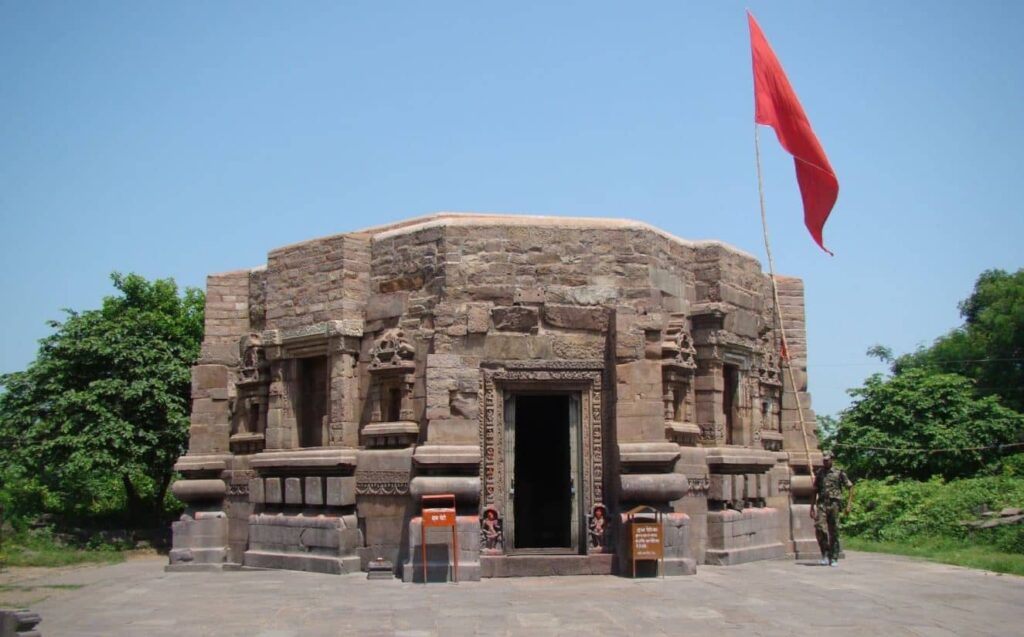
Responses